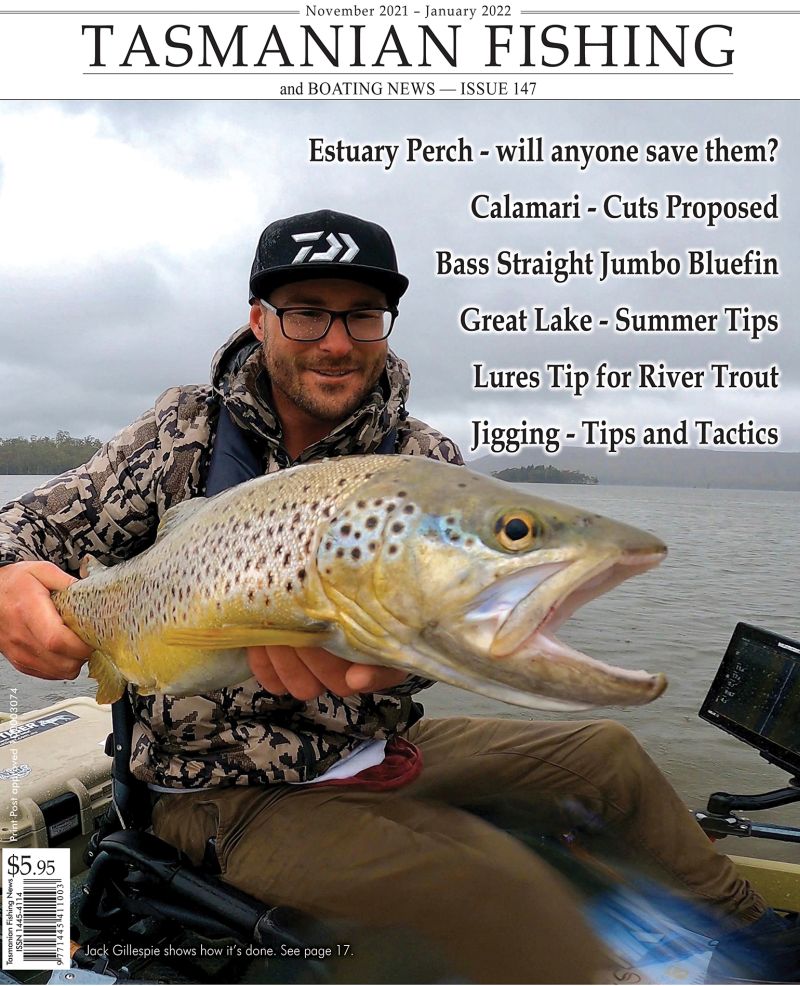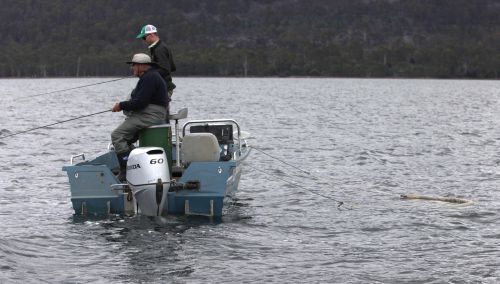Jassid's - As good as it gets!
The Tasmanian fishing season has many highlights for the fly fisher. Early season tailing trout, awesome mayfly hatches and unbelievable polaroiding on blue-sky days are probably what Tasmanian fishing is renowned for.
For the occasional fisher, or even the tourist fisher it is the tailing trout, mayfly hatches and polaroiding that attracts them to Tasmania, but, the fact of the matter may be that the best fishing of the season is to be had at the end of the season in March and April.
As local fly fishers will tell you the gum beetle falls during this period can be great, turning lakes such as Arthur's yellow and green with crunchy offerings. Beetle falls are good but if you look a bit closer amongst these beetles you may recognise another unusual insect, the jassid.
At first appearance jassid's look like little black and red wedges kicking around the water pleading "eat me" but these little beauties are definitely on the menu for big fat trout and can make beetle or mayfly hatches look as exciting as a tooth extraction! Big fish cruising high in the waves or mopping up slicks (wind lanes) are the product of a good "Jassid fall" and this very visual fishing can certainly compete with any fishing at any time of the year.
To find out more about jassid's and the excellent fishing they can create I spoke with four of Tasmania's better known fly fisher's. Here is what they had to say about our sensational jassid fishing!
Jim Allen - Fishing tackle retailer / long term Tasmanian fly fishing addict
When
This year I have discovered jassid's in the first week of February - the earliest I have ever seen jassid's in over thirty years of fishing in the Tasmanian highlands. Typically jassid's begin to show around the third week of March, peaking in April. At approximately this time the jassid numbers dissipate due to the first good autumn "freeze up'. Jassid's can however persist through May, providing that there is no severe weather earlier on in the season. The best time to find jassid feeders is during the middle of the day when the temperature is at its highest. Many people believe that the jassid numbers are cyclical, peaking every seven or twelve years however I do not prescribe to this theory. The jassid's will typically peak accordingly with the climatic conditions.
Jassid's There are two types of Jassid, the little brown Cinnamon jassid leafhopper, which is about the size of two pinheads, and the more common black and red Jassid leafhopper. The large black and red Jassid has black triangular wings with white ribbing whilst the underbelly (abdomen) of the insect is scarlet red. The Cinnamon Jassid can occur on Great Lake or Arthur's lake anytime from December through February and can provide great fishing, however, the black and red jassid often produces the most fantastic fishing - the trout will only eat jassid's some days leaving rafts of beetles unhindered.
Where
Good places to find jassid's include Dee Lagoon, Lake Echo, Little Pine and even the Western Lakes. You do not need gum trees as a necessity to find jassid's, they can be found around to the more barren lakes just as much as more wooded lakes. This could be due to migratory flights?
How I like to fish two flies to jassid feeders with my typical set up consisting of a large dry fly acting as a sighter, such a fly would be a large red tag. Tied of the bend of the large "sighter" fly on a three-foot tippet I would tie a smaller jassid imitation. This set up utilising a large sighter fly is good for those with bad eyesight or for beginners who need help finding their fly. Fish the flies" static. When a rising fish is seen or a fish is polaroided simply place your flies in front of the fish with speed and accuracy. If the fish is taking occasionally and you cannot see where it is heading then cast approximately ten foot upwind of the last rise. As a percentage rule, typically fish will feed upwind where the food drifts towards them whilst they swim into the small surface current.
Peter Hayes - Professional fly fishing guide
Jassid's
To a trout jassid's must surely be the "Turkish Delights" of the insect world. I am not sure why they are so sought after but trout just love them. Perhaps it's the colour- we have known for a long time that fish love red. Perhaps it's simply the taste. Try one and compare it to a Gum Beetle, which is the staple surface food at this time of the season. I am pretty sure you would choose a jassid every time.
Fly Choice
My ten years of guiding experience has taught me that you should always have a Bibio fly on the point of any dry fly leader, regardless of time of the year, but in particular during March and April. Apart from a great general pattern the Bibio is a great caricature of a Jassid. The Bibio is a low sitting fly and to balance this I like to use a high riding Guides Tag as a second fly. A good variation on my original pattern uses black seals fur for the body. The fluoro pink tag certainly has an appeal to the trout that we do not understand. On dozens upon dozens of occasions I have had trout pick this fly in preference to the millions of natural gum beetles rafted together on the water. It is no surprise that when I clean the fish and check the stomach contents I find almost exclusively jassid's and the red-rimmed gum beetles. No green or yellow beetles.
Where and When
Windy, warm days are the best but they are not mandatory. Early to mid afternoon is better than an early start. I prefer to look off the points where the wind draws from two shorelines. Search the foam lines and slicks thoroughly as this is where the volumes of the easier to catch fish will be found. Look for the "oncers" on the calm tree lined shores as a last resort. Finally, strike slowly. The takes are often so very confident.
John Fox - Retired professional trout guide
Jassid's Jassid's are unpredictable; some people believe that they come every 7 years however in my opinion they make up their own minds. The last big fall I seen was in the 70's when they were thick on Penstock Lagoon and it was great fishing at that point. David Scholes recounted to me a story of days gone by at Lake Leake were there was good falls of jassid's. Dee Lagoon has also had good falls in the past so they are definitely a widespread phenomenon. They like it pretty warm as does the gum beetle, typically after midday or 1 o'clock daylight savings time. They are a mid March to late April phenomenon. A jassid is what is known as a leafhopper, they are not a beetle as often referred to. Jassid's are good and capable fliers, they can fly like jets! They are better than gum beetles that get blown around in a breeze, jassid's fly where they want to go.
Flies
Favourite pattern is a big red tag, often with a mixed hackle of furnace and black. The pattern is not important, speed and accuracy when casting is the key to success. My favourite technique for jassid fishing is Polaroiding or finding the rises, all from mid March to late April.
The Cinnamon jassid
The Cinnamon jassid's are great as when the trout start sipping them they stay up on them for hours. This obviously leads to great fishing and is in contrast to a heavy fall of beetles where the fish gorge themselves and get full in minutes. Cinnamon jassid's offer some really great wind lane fishing - as good fishing as you can get!
Bruce Gibson - Commercial fly tier (Gibson Flies)
Where and how The Bronte region is probably my favourite area to find and fish jassid falls. Polaroiding cruising fish on a clear sunny day or wind lane fishing is my preferable method for fishing Jassid falls.
What fly
When fishing to jassid feeders Gibson's Foam Jassid is my favourite pattern in a size 14. Preferably fish the fly static (do not move it) to a fish that you can see. An interesting observation about jassid's is that when the water is smothered in gum beetles the fish will still be picking out the jassid. Trout favour them over anything else and what's more jassid's will bring the really big fish to the dry fly!
Simply the best It is the best fishing you will get! Jassid falls give you the best chance you can get to catch a big fish on the dry fly!
There is no doubt that jassid falls can lead to some of the best, if not the best fly fishing in Tasmania. Whether your Polaroiding big fat brown trout, cruising rainbows or simply fishing the big "gulping" rises, make sure you get out there and give it a go! Develop speed and accuracy when casting, pack a handful of flies with a pair of polaroid's and you have the ingredients for some hard to beat fly fishing.



